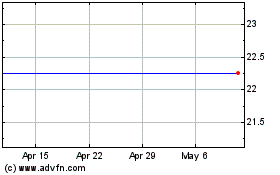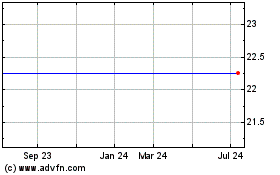Constitution Pipeline Committed to Building Federally Approved Pipeline, Delivering Energy Savings & Environmental Benefits t...
April 25 2016 - 8:30AM
Business Wire
- Company Says New York DEC Statements
Inaccurate, Contradict Facts
- NYSDEC Confirmed Receipt of All
Necessary Data on Dec. 24, 2014
- Company Made Weekly Inquiries to
Department to Ensure Data Completeness For Past Nine Months
- State Decision Delays Significant
Southern Tier Economic Development and Thousands of Jobs
Constitution Pipeline Company, LLC announced today that it
remains steadfastly committed to pursuing the federally-approved
energy infrastructure project, despite the recent decision by the
New York State Department of Environmental Conservation (NYSDEC) to
deny the Section 401 Water Quality Certification for the
Constitution Pipeline Project.
“In spite of NYSDEC’s unprecedented decision, we remain
absolutely committed to building this important energy
infrastructure project, which will create an important connection
between consumers and reliable supplies of clean, affordable
natural gas. We believe NYSDEC’s stated rationale for the denial
includes flagrant misstatements and inaccurate allegations, and
appears to be driven more by New York State politics than by
environmental science,” the project sponsors said in a joint
statement.
Constitution Pipeline worked closely with NYSDEC staff for more
than three years to ensure that water quality measures are met
before, during and after construction. As a result of that
dialogue, Constitution Pipeline voluntarily agreed to the agency’s
requests to incorporate re-routes, adopt trenchless construction
methodologies, commit to site-specific trout stream restoration and
agreed to fund approximately $18 million for wetland mitigation and
banking and approximately $8.6 million for the restoration and
preservation of migratory bird habitats.
“We worked in good faith with the NYSDEC for years, so this
decision comes as a surprise and is contrary to our dialogue and
collaborative effort to address concerns. The FERC-certificated
route was developed after extensive environmental and engineering
analysis, which included a comprehensive review of route
alternatives. In its Final Environmental Impact Statement, the FERC
concluded that environmental impacts associated with these
alternatives were significantly greater than the preferred route.
Despite this, in the spirit of collaboration we followed NYSDEC
guidance and further altered our preferred route to adopt NYSDEC
staff recommendations.”
“We were informed by the NYSDEC that the agency had everything
it needed to process the water quality certification. This point
was further emphasized when the agency issued a notice on Dec. 24,
2014, indicating that the application was indeed administratively
complete.”
“Contrary to NYSDEC statements, the company was not informed of
any outstanding issues that it had not agreed to address as a
condition of the permit. In fact, during the past nine months,
weekly inquiries were made to the department to ensure no
additional data was needed. Those inquiries were either ignored or
responded to in the negative. It is obvious that the NYSDEC
deliberately chose to remain silent to bolster the political
campaign of the State.”
In addition, NYSDEC’s claims regarding Constitution Pipeline’s
knowledge of landowner tree felling activity are completely
inaccurate and contradict the third party environmental monitors
working on behalf of FERC. The federal monitors confirmed that
Constitution was not a party to the tree felling, and their
Environmental Compliance Monitoring Report has been available since
March 18, 2016, to both NYSDEC and the public at:
(http://elibrary.ferc.gov/idmws/file_list.asp?accession_num=20160318-4003).
The company also takes serious issue with claims that its
application lacked information related to stream crossings, depth
of pipe, or blasting.
The project sponsors continued, “Completely contrary to NYSDEC’s
assertion, we provided detailed drawings and profiles for every
stream crossing in New York, including showing depth of pipe. In
fact, all stream crossings were fully vetted with the NYSDEC
throughout the review process. We are appalled with the comments
that Constitution failed to provide sufficient data to ensure every
crossing was totally in compliance with the NYSDEC guidelines.”
“Constitution Pipeline did not refuse to provide a comprehensive
analysis of pipe depth. Constitution committed to bury the pipe at
least five feet or deeper below the lowest bed elevation of the
stream bed in unconsolidated bedrock, which exceeds the federal
regulations for pipe depth. After weekly meetings and site visits
with NYDEC, the company also committed to conduct geo-technical
borings and develop a feasibility report which would be provided to
the NYDEC after the permit was issued for specific stream crossings
which were identified by NYDEC.”
The project sponsors will pursue all available options to
challenge the legality and appropriateness of New York's decision
particularly since it is based primarily on (a) comments previously
made by New York to FERC which FERC carefully considered before
issuing its Certificate of Public Convenience and Necessity for the
Project; and (b) factually inaccurate assumptions and
assertions.
The Federal Energy Regulatory Commission (FERC) on Dec. 2, 2014
issued its certificate of public convenience and necessity for the
Constitution Pipeline. In its final environmental review of the
proposed Constitution Pipeline, FERC concluded that environmental
impacts would be reduced to “less than significant levels” with the
implementation of proposed mitigation measures by the company and
recommendations by FERC.
Denial of the 401 Water Quality Certification by NYSDEC further
delays the potential for Constitution Pipeline to help facilitate
local natural gas service to homes and businesses in Southern New
York, including the installation of delivery taps along
Constitution's proposed route to facilitate local natural gas
service by Leatherstocking Gas Company, LLC to homes and businesses
in southern New York and northern Pennsylvania.
The permit denial will also delay about 2,400 direct and
indirect jobs that would be created during pipeline construction,
generating $130 million in labor income for the region. The
decision could also cost local governments approximately $13
million in annual property tax revenue.
The 2015 New York State Energy Plan specifically recognized the
role of the Constitution Pipeline, projecting that natural gas
usage will increase during the next 15 years, and by 2030, natural
gas will provide the largest share of any single fuel source. Much
of this additional natural gas will be used to help generate
electricity while also enabling the state’s adoption of more
renewable energy sources.
Constitution Pipeline Company
Constitution Pipeline Company, LLC is owned by subsidiaries of
Williams Partners L.P. (NYSE:WPZ), Cabot Oil & Gas Corporation
(NYSE:COG), Piedmont Natural Gas Company, Inc. (NYSE:PNY), and WGL
Holdings, Inc. (NYSE:WGL). The 125-mile pipeline project is
proposed to connect domestic natural gas production in northeastern
Pennsylvania with northeastern markets during the second half of
2017. Additional information about the Constitution Pipeline can be
found at www.constitutionpipeline.com.
Portions of this document may constitute “forward-looking
statements” as defined by federal law. Although the company
believes any such statements are based on reasonable assumptions,
there is no assurance that actual outcomes will not be materially
different. Any such statements are made in reliance on the “safe
harbor” protections provided under the Private Securities Reform
Act of 1995. Additional information about issues that could lead to
material changes in performance is contained in the company’s
annual reports filed with the Securities and Exchange
Commission.
View source
version on businesswire.com: http://www.businesswire.com/news/home/20160425005727/en/
For Constitution Pipeline Company, LLCChris Stockton,
713-215-2010christopher.l.stockton@williams.com
Cabot Oil and Gas (NYSE:COG)
Historical Stock Chart
From Mar 2024 to Apr 2024

Cabot Oil and Gas (NYSE:COG)
Historical Stock Chart
From Apr 2023 to Apr 2024
